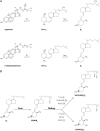The nonskeletal effects of vitamin D: an Endocrine Society scientific statement
- PMID: 22596255
- PMCID: PMC3365859
- DOI: 10.1210/er.2012-1000
The nonskeletal effects of vitamin D: an Endocrine Society scientific statement
Abstract
Significant controversy has emerged over the last decade concerning the effects of vitamin D on skeletal and nonskeletal tissues. The demonstration that the vitamin D receptor is expressed in virtually all cells of the body and the growing body of observational data supporting a relationship of serum 25-hydroxyvitamin D to chronic metabolic, cardiovascular, and neoplastic diseases have led to widespread utilization of vitamin D supplementation for the prevention and treatment of numerous disorders. In this paper, we review both the basic and clinical aspects of vitamin D in relation to nonskeletal organ systems. We begin by focusing on the molecular aspects of vitamin D, primarily by examining the structure and function of the vitamin D receptor. This is followed by a systematic review according to tissue type of the inherent biological plausibility, the strength of the observational data, and the levels of evidence that support or refute an association between vitamin D levels or supplementation and maternal/child health as well as various disease states. Although observational studies support a strong case for an association between vitamin D and musculoskeletal, cardiovascular, neoplastic, and metabolic disorders, there remains a paucity of large-scale and long-term randomized clinical trials. Thus, at this time, more studies are needed to definitively conclude that vitamin D can offer preventive and therapeutic benefits across a wide range of physiological states and chronic nonskeletal disorders.
Figures



References
-
- Rosen CJ. 2011. Vitamin D insufficiency. N Engl J Med 364:248–254 - PubMed
-
- Holick MF, Binkley NC, Bischoff-Ferrari HA, Gordon CM, Hanley DA, Heaney RP, Murad MH, Weaver CM. 2011. Evaluation, treatment, and prevention of vitamin D deficiency: an Endocrine Society Clinical Practice Guideline. J Clin Endocrinol Metab 96:1911–1930 - PubMed
-
- IOM (Institute of Medicine) 2011. Dietary reference intakes for calcium and vitamin D. Washington, DC: The National Academies Press - PubMed
-
- McDonnell DP, Mangelsdorf DJ, Pike JW, Haussler MR, O'Malley BW. 1987. Molecular cloning of complementary DNA encoding the avian receptor for vitamin D. Science 235:1214–1217 - PubMed
Publication types
MeSH terms
Substances
Grants and funding
- UL1 RR033176/RR/NCRR NIH HHS/United States
- R01 AR050023/AR/NIAMS NIH HHS/United States
- R21 AR056885/AR/NIAMS NIH HHS/United States
- MOP-84253/CAPMC/ CIHR/Canada
- R01AI073539/AI/NIAID NIH HHS/United States
- UL1 TR000124/TR/NCATS NIH HHS/United States
- I01 BX001066/BX/BLRD VA/United States
- CA13896/CA/NCI NIH HHS/United States
- DK092759/DK/NIDDK NIH HHS/United States
- R01 AI073539/AI/NIAID NIH HHS/United States
- UL1RR033176/RR/NCRR NIH HHS/United States
- UL1TR000124/TR/NCATS NIH HHS/United States
- DK46974/DK/NIDDK NIH HHS/United States
- R24 DK092759/DK/NIDDK NIH HHS/United States
- T32 AR059033/AR/NIAMS NIH HHS/United States
- U01 CA138962/CA/NCI NIH HHS/United States
- T32AR059033/AR/NIAMS NIH HHS/United States
- R01 DK046974/DK/NIDDK NIH HHS/United States
- R21AR056885/AR/NIAMS NIH HHS/United States
LinkOut - more resources
Full Text Sources
Other Literature Sources
Medical

